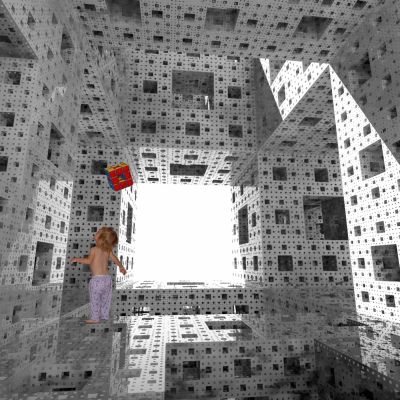|
Nice thing about
the Menger Sponge is that it is all over the web, easy to get different views of.
One of the more famous fractal structures, it is a cube made of cubes. Although
the cube has 8 vertices, the cube
fractal grows in powers of 20. This breaks from the pattern of the other Platonic solids,
where the number of vertices and the power of the exponential growth of their
associated fractal structure is the same. For instance, the icosahedron has 12 vertices and
the icosahedron fractal
grows in powers of 12.
Below is an image that combines the two referenced above. Anyone wanting to reproduce
it must get permission from Paul Bourke.
The enlargement is 1000x1000 pixcels, not the correct proportion for most monitor screens, so
your desktop should be set to 'center' if using it for wallpaper, since a setting of
'stretch' will distort the image.
|
|
One thing happening with this fractal is that a cube (hexahedron) is being emptied of its volume in iterative stages. Consider a whole cube, of any size: that is the stage-0 Menger sponge. Cut it into 27 equal cubes and remove 7/27's of the volume by taking out the seven centerparts (see the stage-1 above), leaving 20/27's of a cube: the stage-1 sponge. Repeating this process with each remaining cube section removes another 7/27's of the volume: the stage-2 sponge, and on and on. By stage-20, the sponge retains only 0.00249...... or ~1/4 of one percent of the volume of a cube. The idea is that at some unknown iteration, some stage-N, the sponge will achieve perfect self-similarity, where every part will be a miniature version of the whole. When this theoretical event occurs, the Menger sponge will have become virtually empty, infinitely complex, and a fractal in the technical sense of the term. |
|
The contents of this web page are © Copyright Gayla Chandler and Paul Bourke. Permission must be sought for all but personal use for study or enjoyment. |
